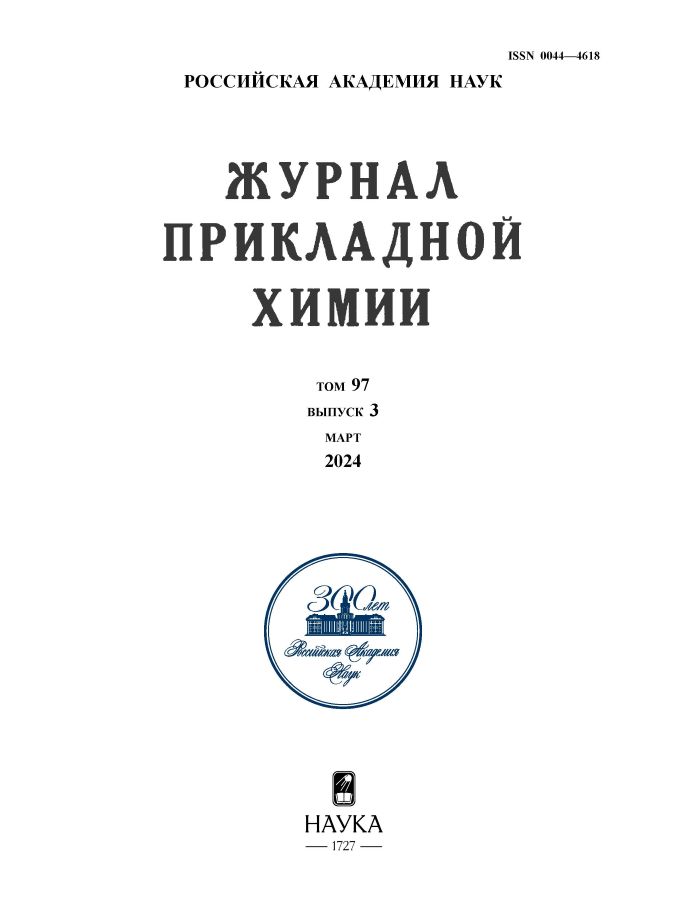Methods to quantify active substances in hawthorn berries and hawthorn berry medicinal products
- 作者: Shefer E.P.1, Antonova N.P.1, Semenova N.E.1, Golomazova T.А.1, Kakhramanova S.D.1, Prokhvatilova S.S.1, Kuchugurin S.А.1
-
隶属关系:
- Scientific Centre for Expert Evaluation of Medicinal Products
- 期: 卷 97, 编号 3 (2024)
- 页面: 198-208
- 栏目: Applied Chemistry - Pharmacy
- URL: https://cardiosomatics.ru/0044-4618/article/view/668102
- DOI: https://doi.org/10.31857/S0044461824030034
- EDN: https://elibrary.ru/NPVTZE
- ID: 668102
如何引用文章
详细
Introduction. The State Pharmacopoeia of the Russian Federation requires that the total flavonoid content in hawthorn berries and hawthorn tincture should be determined using spectrophotometry. The current analytical procedure has significant limitations, including low selectivity, poor accuracy, and inability to determine the components of active substances individually. These limitations can be eliminated by using other instrumental methods. In a previous paper, the authors proposed an analytical procedure for the quantitative determination of active substances in hawthorn flowers by high-performance liquid chromatography (HPLC). With the similar chemical compositions of hawthorn flowers and berries, a similar analytical procedure can be developed to determine the total flavonoid content in hawthorn berries and hawthorn tincture.
Aim. This study aimed to develop an HPLC procedure to determine the total flavonoid content in hawthorn berries and hawthorn tincture; additionally, the authors aimed to suggest approaches to harmonising the methods for the quantitative determination of active substances in hawthorn berries with the methods outlined in the leading pharmacopoeias.
Materials and methods. The study focused on the Hawthorn Berries and Hawthorn Tincture herbal medicines from Russian manufacturers. The authors used HPLC on an Infinity II 1260 DAD chromatograph, spectrophotometry on an Agilent 8453E spectrophotometer, and acid–base titration. The sample preparation procedure involved using a continuous extraction apparatus. The loss on drying was determined using a drying chamber. Quercetin dihydrate CRS (European Pharmacopoeia) was used as a reference standard.
Results. A comprehensive review of the approaches of the leading pharmacopoeias to the standardisation of assays for hawthorn berries showed the potential for developing a selective analytical procedure for flavonoid quantification by HPLC. The review demonstrated that it was feasible to standardise procyanidins, expressed as cyanidin chloride. The authors considered it unnecessary to introduce an analytical procedure to determine the organic acids in hawthorn berries, similar to that required by the Pharmacopoeia of the People’s Republic of China, in the State Pharmacopoeia of the Russian Federation since the berries of Russian officinal species have much lower organic acid levels than the berries of the hawthorn species described in the Pharmacopoeia of the People’s Republic of China.
Conclusions. The authors suggested and validated an HPLC procedure to determine the total flavonoid content, expressed as hyperoside, in hawthorn berries and hawthorn tincture and recommended that the pharmacopoeia monograph on hawthorn berries should include the quantitative determination of procyanidins, expressed as cyanidin chloride.
全文:
作者简介
Elena Shefer
Scientific Centre for Expert Evaluation of Medicinal Products
编辑信件的主要联系方式.
Email: shefer@expmed.ru
ORCID iD: 0000-0001-8389-4799
канд. фарм. наук
俄罗斯联邦, 127051, Moscow, 8/2 Petrovsky BlvdNatalia Antonova
Scientific Centre for Expert Evaluation of Medicinal Products
Email: shefer@expmed.ru
ORCID iD: 0000-0002-7818-5303
канд. биол. наук
俄罗斯联邦, 127051, Moscow, 8/2 Petrovsky BlvdNatalia Semenova
Scientific Centre for Expert Evaluation of Medicinal Products
Email: shefer@expmed.ru
ORCID iD: 0000-0002-6787-0647
俄罗斯联邦, 127051, Moscow, 8/2 Petrovsky Blvd
Tatyana Golomazova
Scientific Centre for Expert Evaluation of Medicinal Products
Email: shefer@expmed.ru
ORCID iD: 0000-0002-9917-9367
俄罗斯联邦, 127051, Moscow, 8/2 Petrovsky Blvd
Sabina Kakhramanova
Scientific Centre for Expert Evaluation of Medicinal Products
Email: shefer@expmed.ru
ORCID iD: 0000-0002-8160-7829
俄罗斯联邦, 127051, Moscow, 8/2 Petrovsky Blvd
Svetlana Prokhvatilova
Scientific Centre for Expert Evaluation of Medicinal Products
Email: shefer@expmed.ru
ORCID iD: 0000-0002-3278-1994
канд. фарм. наук
俄罗斯联邦, 127051, Moscow, 8/2 Petrovsky BlvdSergey Kuchugurin
Scientific Centre for Expert Evaluation of Medicinal Products
Email: shefer@expmed.ru
ORCID iD: 0000-0001-9439-9611
俄罗斯联邦, 127051, Moscow, 8/2 Petrovsky Blvd
参考
- Морозова Т. В., Куркина А. В., Правдивцева О. Е., Дубищев А. В., Куркин В. А., Зайцева Е. Н. Фармакогностическое и фармакологическое исследование сырья боярышника // Изв. Самар. науч. центра РАН. 2015. Т. 17. № 5–3. С. 959–963. https://www.elibrary.ru/wfcbgx
- Гусалова М. И., Хмелевская А. В., Черчесова С. К. Изучение химического состава плодов боярышника кроваво-красного (Crataesus sanguinea Pall.) и шиповника коричного (Rosa cinnamonica L.) // Изв.Горск. гос. аграр. ун-та. 2019. Т. 56 (2). С. 111–115. https://www.elibrary.ru/amivvj
- Cosmulescu S. N., Trandafir I., Scrieciu F., Stoenescu A. M. Content in organic acids of Mespilus spp. and Crataegus spp. genotypes // Notulae Botanicae Horti Agrobotanici Cluj-Napoca. 2020. V. 48 (1). P. 171–176. https://doi.org/10.15835/nbha48111746
- Svedström U., Vuorela H., Kostiainen R., Laakso I., Hiltunen R. Fractionation of polyphenols in hawthorn into polymeric procyanidins, phenolic acids and flavonoids prior to high-performance liquid chromatographic analysis // J. Chromatogr. A. 2006. V. 1112. N 1–2. P. 103–11. https://doi.org/10.1016/j.chroma.2005.12.080
- Хишова О. М., Бузук Г. Н. Количественное определение процианидинов плодов боярышника // Хим.-фарм. журн. 2006. Т. 40. № 2. С. 20–21. https://www.elibrary.ru/taligp [Khishova O. M., Buzuk G. N. Quantitative determination of procyanidins in hawthorn fruits // Pharm. Chem. J. 2006. V. 40. N 2. P. 79–81. https://doi.org/10.1007/s11094-006-0063-1].
- Yang B., Liu P. Composition and health effects of phenolic compounds in hawthorn (Crataegus spp.) of different origins // J. Sci. Food Agric. 2012. V. 92 (8). P. 1578–1590. https://doi.org/10.1002/jsfa.5671
- Orhan I. E. Phytochemical and pharmacological activity profile of Crataegus oxyacantha L. (Hawthorn) — a cardiotonic herb // Curr. Med. Chem. 2018. V. 25. N 37. P. 4854–4865. https://doi.org/10.2174/0929867323666160919095519
- Морозова Т. В., Куркин В. А., Правдивцева О. Е. Актуальные проблемы химической стандартизации сырья лекарственных растений рода боярышник (Crataegus L.) // Фармация и фармакология. 2018. V. 6 (2). P. 104–120. https://doi.org/10.19163/2307-9266-2018-6-2-104-120
- Антонова Н. П., Шефер Е. П., Семенова Н. Е., Калинин А. М., Прохватилова С. С., Моргунов И. М. Применение метода ВЭЖХ для экспертизы и стандартизации лекарственного растительного сырья «Боярышника цветки» // Ведомости Научного центра экспертизы средств медицинского применения. 2019. Т. 9. № 3. С. 177–183. https://doi.org/10.30895/1991-2919-2019-9-3-177-183
- Буданцев А. Л., Беленовская Л. М., Битюкова Н. В. Компонентный состав и биологическая активность Crataegus pinnatifida (Rosaceae) (обзор) // Химия раст. сырья. 2020. Т. 4. С. 31–58. https://doi.org/10.14258/jcprm.2020046612
补充文件











